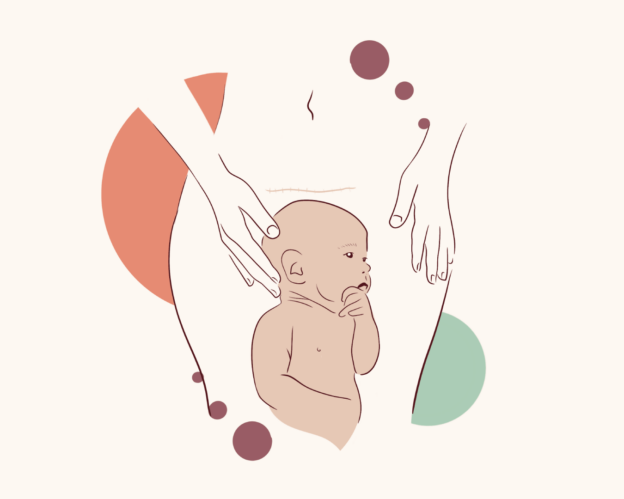Geschreven door Margot van Dijk
Gepubliceerd op 15 juli 2022
In 2020 beviel in Nederland 18,6% van de nullipara per keizersnede en 16,3% van de multipara baarde haar kind(eren) per keizersnede. Als deze vrouwen opnieuw zwanger raken, komen zij voor de keuze te staan wat zij een volgende baring willen: vaginaal bevallen of een geplande keizersnede. Een vaginale baring na een eerdere keizersnede wordt ook wel een VBAC genoemd: Vaginal Birth After a Caesarean. Als een zwangere kiest voor een VBAC, is dit volgens de richtlijn een indicatie om in de tweedelijn te baren met CTG-registratie.
Wat zijn de risico’s van een VBAC en wat is de kans om daadwerkelijk vaginaal te baren? Wat zijn de risico’s van een geplande keizersnede na een eerdere keizersnede? Wat is de onderbouwing van de richtlijn om in de tweedelijn met CTG-registratie te baren? En zijn er nog meer mogelijkheden dan een vaginale baring of een geplande keizersnede? In dit artikel worden deze en nog meer vragen beantwoord.
American College of Obstetricians and Gynecologists. (2019). ACOG Practice Bulletin No. 205. Vaginal birth after cesarean delivery. Obstetrics & Gynecology, 133(2), e110-e127. https://journals.lww.com/greenjournal/Abstract/2019/02000/ACOG_Practice_Bulletin_No__205__Vaginal_Birth.40.aspx
Awonuga, A. O., Fletcher, N. M., Saed, G. M., & Diamond, M. P. (2011). Postoperative adhesion development following cesarean and open intra-abdominal gynecological operations: a review. Reproductive sciences (Thousand Oaks, Calif.), 18(12), 1166–1185. https://doi.org/10.1177/1933719111414206
Barger, M. K., Nannini, A., Weiss, J., Declercq, E. R., Stubblefield, P., Werler, M., & Ringer, S. (2012). Severe maternal and perinatal outcomes from uterine rupture among women at term with a trial of labor. Journal of Perinatology, 32(11), 837–843. https://doi.org/10.1038/jp.2012.2
Bayrampour, H., Lisonkova, S., Tamana, S., Wines, J., Vedam, S., & Janssen, P. (2021). Perinatal outcomes of planned home birth after cesarean and planned hospital vaginal birth after cesarean at term gestation in British Columbia, Canada: A retrospective population-based cohort study. Birth (Berkeley, Calif.), 48(3), 301–308. https://doi.org/10.1111/birt.12539
Boske, E. C. E. (2019). Praktijkvariatie gentle sectio caesarea bij ziekenhuizen in Noord-Nederland. NTOG, 132, 17–20. https://www.nvog.nl/wp-content/uploads/2019/06/NTOG_2019-1.pdf
Buckley, S. (2015, januari). Hormonal Physiology of Childbearing: Evidence and Implications for Women, Babies, and Maternity Care. Childbirth Connection. https://www.nationalpartnership.org/our-work/resources/health-care/maternity/hormonal-physiology-of-childbearing.pdf
Bujold, E., Hammoud, A., Schild, C., Krapp, M., & Baumann, P. (2005). The role of maternal body mass index in outcomes of vaginal births after cesarean. American journal of obstetrics and gynecology, 193(4), 1517–1521. https://doi.org/10.1016/j.ajog.2005.03.041
Cahill A, Stamilio DM, Pare E, Peipert JP, Stevens EJ, Nelson DB, et al. Vaginal birth after cesarean (VBAC) attempt in twin pregnancies: is it safe?. American Journal of Obstetrics & Gynecology 2005 Sep;193(3 Pt 2):1050-1055.
Chaichian, S., Akhlaghi, A., Rousta, F., & Safavi, M. (2009). Experience of water birth delivery in Iran. Archives of Iranian medicine, 12(5), 468–471. Callahan C, Chescheir N, Steiner BD. Safety and efficacy of attempted vaginal birth after cesarean beyond the estimated date of delivery. J Reprod Med 1999 Jul;44(7):606-610.
Chaichian, S., Akhlaghi, A., Rousta, F., & Safavi, M. (2009). Experience of water birth delivery in Iran. Archives of Iranian medicine, 12(5), 468–471. Chibber, R., El-Saleh, E., Al Fadhli, R., Al Jassar, W., & Al Harmi, J. (2010). Uterine rupture and subsequent pregnancy outcome--how safe is it? A 25-year study. The journal of maternal-fetal & neonatal medicine : the official journal of the European Association of Perinatal Medicine, the Federation of Asia and Oceania Perinatal Societies, the International Society of Perinatal Obstetricians, 23(5), 421–424. https://doi.org/10.3109/14767050903440489
Coassolo KM, Stamilio DM, Pare E, Peipert JF, Stevens E, Nelson DB, et al. Safety and efficacy of vaginal birth after cesarean attempts at or beyond 40 weeks of gestation. Obstetrics & Gynecology 2005 10;106(4):700-706. Cox K. J. (2016). Vaginal birth after caesarean at home in England: an opportunity for shared decision-making. Evidence-based nursing, 19(4), 115. https://doi.org/10.1136/eb-2016-102452
De Costa, C. (2005). Vaginal birth after classical Caesarean section. Australian and New Zealand Journal of Obstetrics and Gynaecology, 45, 182-186. https://doi.org/10.1111/j.1479-828X.2005.00387.x
Dewhurst, C. (1956). Reports of societies - rupture of the uterus. The Journal of Obstetrics and Gynaecology of the British Empire, 63, 125-129.
van Dillen, J., Zwart, J., Schutte, J., Bloemenkamp, K., & van Roosmalen, J. (2010). Severe acute maternal morbidity and mode of delivery in the Netherlands. Acta Obstetricia Et Gynecologica Scandinavica, 89(11), 1460-1465.
Dombrowski, M., Illuzzi, J. L., Reddy, U. M., Lipkind, H. S., Lee, H. C., Lin, H., Lundsberg, L. S., & Xu, X. (2020). Trial of Labor After Two Prior Cesarean Deliveries: Patient and Hospital Characteristics and Birth Outcomes. Obstetrics and gynecology, 136(1), 109–117. https://doi.org/10.1097/AOG.0000000000003845
Elkousy MA, Sammel M, Stevens E, Peipert JF, Macones G. The effect of birth weight on vaginal birth after cesarean delivery success rates. American Journal of Obstetrics & Gynecology 2003 03;188(3):824-830.
Ellekjaer, K. L., Bergholt, T., & Løkkegaard, E. (2017). Maternal obesity and its effect on labour duration in nulliparous women: a retrospective observational cohort study. BMC pregnancy and childbirth, 17(1), 222. https://doi.org/10.1186/s12884-017-1413-6
Eshkoli, T., Weintraub, A. Y., Sergienko, R., & Sheiner, E. (2013). Placenta accreta: risk factors, perinatal outcomes, and consequences for subsequent births. American Journal of Obstetrics and Gynecology, 208(3), 219.e1-219.e7. https://doi.org/10.1016/j.ajog.2012.12.037
Fitzpatrick, K. E., Kurinczuk, J. J., Alfirevic, Z., Spark, P., Brocklehurst, P., & Knight, M. (2012). Uterine rupture by intended mode of delivery in the UK: a national case-control study. PLoS medicine, 9(3), e1001184. https://doi.org/10.1371/journal.pmed.1001184
Gayiti, M. R., Li, X. Y., Zulifeiya, A. K., Huan, Y., & Zhao, T. N. (2015). Comparison of the effects of water and traditional delivery on birthing women and newborns. European review for medical and pharmacological sciences, 19(9), 1554–1558.
Greene, R. A., Fitzpatrick, C., & Turner, M. J. (1998). What are the maternal implications of a classical caesarean section?. Journal of obstetrics and gynaecology : the journal of the Institute of Obstetrics and Gynaecology, 18(4), 345–347. https://doi.org/10.1080/01443619867083
Grobman, W. A., Sandoval, G., Rice, M. M., Bailit, J. L., Chauhan, S. P., Costantine, M. M., Gyamfi-Bannerman, C., Metz, T. D., Parry, S., Rouse, D. J., Saade, G. R., Simhan, H. N., Thorp, J. M., Tita, A. T., Longo, M., & Landon, M. B. (2021). Prediction of vaginal birth after cesarean delivery in term gestations: a calculator without race and ethnicity. American Journal of Obstetrics and Gynecology, 225(6), 664.e1-664.e7. https://doi.org/10.1016/j.ajog.2021.05.021
Guiliano, M., Closset, E., Therby, D., LeGoueff, F., Deruelle, P., & Subtil, D. (2014). Signs, symptoms and complications of complete and partial uterine ruptures during pregnancy and delivery. European journal of obstetrics, gynecology, and reproductive biology, 179, 130–134. https://doi.org/10.1016/j.ejogrb.2014.05.004
Guise JM, Eden K, Emeis C, et al. Vaginal Birth After Cesarean: New Insights. Rockville (MD): Agency for Healthcare Research and Quality (US); 2010 Mar. (Evidence Reports/Technology Assessments, No. 191.) Available from: https://www.ncbi.nlm.nih.gov/books/NBK44571/
Jastrow N, Roberge S, Gauthier RJ, Laroche L, Duperron L, Brassard N, et al. Effect of birth weight on adverse obstetric out- comes in vaginal birth after cesarean delivery. Obstet Gynecol 2010 Feb;115(2 Pt 1):338-343.
Keag, O. E., Norman, J. E., & Stock, S. J. (2018). Long-term risks and benefits associated with cesarean delivery for mother, baby, and subsequent pregnancies: Systematic review and meta-analysis. PLoS medicine, 15(1), e1002494. https://doi.org/10.1371/journal.pmed.1002494
Kramer, H. M. C., Kwee, A., & Bremer, H. A. (2009). Eens een sectio, altijd een sectio? Ned. Tijdschr Geneeskunde, 153. https://www.ntvg.nl/system/files/publications/b49.pdf Kwee, A., Bots, M. L., Visser, G. H., & Bruinse, H. W. (2007). Obstetric management and outcome of pregnancy in women with a history of caesarean section in the Netherlands. European journal of obstetrics, gynecology, and reproductive biology, 132(2), 171–176. https://doi.org/10.1016/j.ejogrb.2006.07.017
Landon, M. B., Hauth, J. C., Leveno, K. J., Spong, C. Y., Leindecker, S., Varner, M. W., Moawad, A. H., Caritis, S. N., Harper, M., Wapner, R. J., Sorokin, Y., Miodovnik, M., Carpenter, M., Peaceman, A. M., O'Sullivan, M. J., Sibai, B., Langer, O., Thorp, J. M., Ramin, S. M., Mercer, B. M., … National Institute of Child Health and Human Development Maternal-Fetal Medicine Units Network (2004). Maternal and perinatal outcomes associated with a trial of labor after prior cesarean delivery. The New England journal of medicine, 351(25), 2581–2589. https://doi.org/10.1056/NEJMoa040405
Landon, M. B., Spong, C. Y., Thom, E., Hauth, J. C., Bloom, S. L., Varner, M. W., … & National Institute of Child Health and Human Development Maternal-Fetal Medicine Units Network. (2006). Risk of uterine rupture with a trial of labor in women with multiple and single prior cesarean delivery. Obstetrics & Gynecology, 108(1), pp.12-20. https://doi.org/10.1097/01.AOG.0000224694.32531.f3
Landon, M. B., & Lynch, C. D. (2011). Optimal timing and mode of delivery after cesarean with previous classical incision or myomectomy: a review of the data. Seminars in Perinatology, 35(5), 257-261. https://doi.org/10.1053/j.semperi.2011.05.008
Lim, K. M., Tong, P. S., & Chong, Y. S. (2016). A comparative study between the pioneer cohort of waterbirths and conventional vaginal deliveries in an obstetrician-led unit in Singapore. Taiwanese journal of obstetrics & gynecology, 55(3), 363–367. https://doi.org/10.1016/j.tjog.2016.04.012
Luckas, M. J., & Wray, S. (2005). A comparison of the contractile properties of human myometrium obtained from the upper and lower uterine segments. BJOG, 107(10), 1309-1311. https://doi.org/10.1111/j.1471-0528.2000.tb11626.x Lyell D. J. (2011). Adhesions and perioperative complications of repeat cesarean delivery. American journal of obstetrics and gynecology, 205(6 Suppl), S11–S18. https://doi.org/10.1016/j.ajog.2011.09.029
Macfarlane, A., Blondel, B., Mohangoo, A., Cuttini, M., Nijhuis, J., Novak, Z., Ólafsdóttir, H., Zeitlin, J., & Zeitlin, J. (2016). Wide differences in mode of delivery within Europe: risk‐stratified analyses of aggregated routine data from the Euro‐Peristat study. BJOG : An International Journal of Obstetrics & Gynaecology, 123(4), 559-568.
Macones, G. A., Cahill, A., Pare, E., Stamilio, D. M., Ratcliffe, S., Stevens, E., … & Peipert, J. (2005). Obstetric outcomes in women with two prior cesarean deliveries: is vaginal birth after cesarean delivery a viable option? American Journal of Obstetrics and Gynecology, 192(4), pp.1223-1228. https://doi.org/10.1016/j.ajog.2004.12.082
McKenna, J. A., & Symon, A. G. (2014). Water VBAC: exploring a new frontier for women's autonomy. Midwifery, 30(1), e20–e25. https://doi.org/10.1016/j.midw.2013.10.004 Miller, E. S., & Grobman, W. A. (2015). Obstetric outcomes associated with induction of labor after 2 prior cesarean deliveries. American journal of obstetrics and gynecology, 213(1), 89.e1–89.e5. https://doi.org/10.1016/j.ajog.2015.02.003
Mogos, M. F., Salemi, J. L., Ashley, M., Whiteman, V. E., & Salihu, H. M. (2016). Recent trends in placenta accreta in the United States and its impact on maternal-fetal morbidity and healthcare-associated costs, 1998-2011. The journal of maternal-fetal & neonatal medicine : the official journal of the European Association of Perinatal Medicine, the Federation of Asia and Oceania Perinatal Societies, the International Society of Perinatal Obstetricians, 29(7), 1077–1082. https://doi.org/10.3109/14767058.2015.1034103
Nahum, G. G., MD. (2020, 27 augustus). Uterine Rupture in Pregnancy: Overview, Rupture of the Unscarred Uterus, Previous Uterine Myomectomy and Uterine Rupture. Https://Reference.Medscape.Com/Article/275854-Overview?Reg=1. Geraadpleegd op 22 juni 2022, van https://reference.medscape.com/article/275854-overview?reg=1
NICE (2019). Intrapartum care for women with existing medical conditions or obstetric complications and their babies. https://www.nice.org.uk/guidance/ng121
NICE (2021). Caesarean birth. https://www.nice.org.uk/guidance/ng192
Nilsson, C., van Limbeek, E., Vehvilainen-Julkunen, K., & Lundgren, I. (2017). Vaginal Birth After Cesarean. Qualitative Health Research, 27(3), 325-340.
NVOG (2010). ZWANGERSCHAP EN BEVALLING NA EEN VOORGAANDE SECTIO CAESAREA, versie 1.0. https://www.nvog.nl/wp-content/uploads/2017/12/Zwangerschap-en-bevalling-na-een-voorgaande-sectio-caesarea-1.0-04-06-2010.pdf
O’Brien JM, Barton JR, Donaldson ES. The management of placenta percreta: conservative and operative strategies. Am J Obstet Gynecol 1996;175:1632–8.
Peristat.nl. (2020). Peristat. Geraadpleegd op 31 maart 2022, van https://www.peristat.nl/ RCOG (2015). Birth after previous caesarean birth. https://www.rcog.org.uk/media/kpkjwd5h/gtg_45.pdf
RCOG (2018). Placenta Praevia and Placenta Accreta: Diagnosis and Management. https://www.rcog.org.uk/media/r1cpqapm/bjog-2018-jauniaux-placenta-praevia-and-placenta-accreta-diagnos.pdf
Reyes-Ceja, L., Cabrera, R., Insfran, E., & Herrera-Lasso, F. (1969). Pregnancy following previous uterine rupture. Study of 19 patients. Obstetrics and gynecology, 34(3), 387–389.
Sandall, J., Tribe, R. M., Avery, L., Mola, G., Visser, G. H., Homer, C. S., Gibbons, D., Kelly, N. M., Kennedy, H. P., Kidanto, H., Taylor, P., & Temmerman, M. (2018). Short-term and long-term effects of caesarean section on the health of women and children. Lancet (London, England), 392(10155), 1349–1357. https://doi.org/10.1016/S0140-6736(18)31930-5
Sargent, J., Dissanayake, M., Skeith, A., & Caughey, A. (2018). Outcomes following uterine rupture during a trial of labor after cesarean: A 2012-2015 national cohort. Am J Obstet Gynecol, S241. Retrieved from http://www.ajog.org/article/S0002-9378(17)31567-3/...
Schoorel, E., Melman, S., Van Kuijk, S., Grobman, W., Kwee, A., Mol, B., Nijhuis, J., Smits, L., Aardenburg, R., De Boer, K., Delemarre, F., Van Dooren, I., Franssen, M., Kleiverda, G., Kaplan, M., Kuppens, S., Lim, F., Sikkema, J., Smid-Koopman, E., . . . Scheepers, H. (2014). Predicting successful intended vaginal delivery after previous caesarean section: external validation of two predictive models in a Dutch nationwide registration-based cohort with a high intended vaginal delivery rate. BJOG: An International Journal of Obstetrics & Gynaecology, 121(7), 840–847. https://doi.org/10.1111/1471-0528.12605
Schoorel, E. N. C. (2015). Pregnancy after caesarean : current care, clinical prediction and risk counselling. Uitgeverij BOXPress. https://doi.org/10.26481/dis.20150623es
Shamshirsaz AA, Fox KA, Salmanian B, Diaz-Arrastia CR, Lee W, Baker BW, et al. Maternal morbidity in patients with morbidly adherent placenta treated with and without a standardized multidisciplinary approach. Am J Obstet Gynecol 2015;212:218.e1-9
Silver, R. (2015). Abnormal Placentation Placenta Previa, Vasa Previa, and Placenta Accreta. Obstetrics & Gynecology, 126(3), 654–668-654&ndash-ndash;668-654–668.
Silver, R. M., Landon, M. B., Rouse, D. J., Leveno, K. J., Spong, C. Y., Thom, E. A., Moawad, A. H., Caritis, S. N., Harper, M., Wapner, R. J., Sorokin, Y., Miodovnik, M., Carpenter, M., Peaceman, A. M., O'Sullivan, M. J., Sibai, B., Langer, O., Thorp, J. M., Ramin, S. M., Mercer, B. M., … National Institute of Child Health and Human Development Maternal-Fetal Medicine Units Network (2006). Maternal morbidity associated with multiple repeat cesarean deliveries. Obstetrics and gynecology, 107(6), 1226–1232. https://doi.org/10.1097/01.AOG.0000219750.79480.84
Srinivas, S. K., Stamilio, D. M., Sammel, M. D., Stevens, E. J., Peipert, J. F., Odibo, A. O., & Macones, G. A. (2007). Vaginal birth after caesarean delivery: does maternal age affect safety and success?. Paediatric and perinatal epidemiology, 21(2), 114–120. https://doi.org/10.1111/j.1365-3016.2007.00794.x
Tahseen, S., & Griffiths, M. (2010). Vaginal birth after two caesarean sections (VBAC‐2)—a systematic review with meta‐analysis of success rate and adverse outcomes of VBAC‐2 versus VBAC‐1 and repeat (third) caesarean sections. BJOG: An International Journal of Obstetrics & Gynaecology, 117(1), 5-19. https://doi.org/10.1111/j.1471-0528.2009.02351.x
Togioka BM, Tonismae T. Uterine Rupture. [Updated 2022 May 3]. In: StatPearls [Internet]. Treasure Island (FL): StatPearls Publishing; 2022 Jan-. Available from: https://www.ncbi.nlm.nih.gov/books/NBK559209/
Vahanian, S. A., Lavery, J. A., Ananth, C. V., & Vintzileos, A. (2015). Placental implantation abnormalities and risk of preterm delivery: a systematic review and metaanalysis. American journal of obstetrics and gynecology, 213(4 Suppl), S78–S90. https://doi.org/10.1016/j.ajog.2015.05.058
Vankan, E., van Kuijk, S., Nijhuis, J. G., Aardenburg, R., Delemarre, F., Dirksen, C. D., van Dooren, I. M., Kuppens, S., Kwee, A., Langenveld, J., Schoorel, E. N., Smits, L. J., Hermens, R. P., & Scheepers, H. C. (2020). External validation of a prediction model on vaginal birth after caesarean in a The Netherlands: a prospective cohort study. Journal of perinatal medicine, 49(3), 357–363. https://doi.org/10.1515/jpm-2020-0308
Varner MW, Leindecker S, Spong CY, Moawad AH, Hauth JC, Landon MB, et al. The Maternal-Fetal Medicine Unit cesarean registry: trial of labor with a twin gestation. American Journal of Obstetrics & Gynecology 2005 Jul;193(1):135-140.
Vissers, J., Hehenkamp, W., Lambalk, C. B., & Huirne, J. A. (2020). Post-Caesarean section niche-related impaired fertility: hypothetical mechanisms. Human Reproduction, 35(7), 1484–1494. https://doi.org/10.1093/humrep/deaa094
Vlemminx, M. W., de Lau, H., & Oei, S. G. (2017). Tocogram characteristics of uterine rupture: a systematic review. Archives of gynecology and obstetrics, 295(1), 17–26. https://doi.org/10.1007/s00404-016-4214-7 Woodward, J., & Kelly, S. M. (2004). A pilot study for a randomised controlled trial of waterbirth versus land birth. BJOG : an international journal of obstetrics and gynaecology, 111(6), 537–545. https://doi.org/10.1111/j.1471-0528.2004.00132.x
Young, C. B., Liu, S., Muraca, G. M., Sabr, Y., Pressey, T., Liston, R. M., Joseph, K. S., & Canadian Perinatal Surveillance System (2018). Mode of delivery after a previous cesarean birth, and associated maternal and neonatal morbidity. CMAJ : Canadian Medical Association journal = journal de l'Association medicale canadienne, 190(18), E556–E564. https://doi.org/10.1503/cmaj.170371
Zwart, J. J., Richters, J. M., Ory, F., de Vries, J. I., Bloemenkamp, K. W., & van Roosmalen, J. (2008). Severe maternal morbidity during pregnancy, delivery and puerperium in the Netherlands: a nationwide population-based study of 371,000 pregnancies. BJOG : an international journal of obstetrics and gynaecology, 115(7), 842–850. https://doi.org/10.1111/j.1471-0528.2008.01713.x
>

Reacties
Je moet ingelogd zijn op om een reactie te plaatsen.



Hebben jullie iets kunnen vinden over de kans op een uterusruptuur bij gebruik van synthetische oxytocine?
Jazeker! Je vindt het in de paragraaf ‘Wat is de onderbouwing van het beleid?’: die kans is ongeveer 1-1,3%
Thanks!
Ik heb een cliënt die kiest voor een VBAC. Nu wil ze graag acupressuur gebruiken om haar lichaam voor te bereiden en hoopt ze hiermee ook niet ver over 40 weken te gaan (o.a. ivm grootte baby). Gynaecoloog geeft aan dit beter niet te doen vanwege hoger risico op uterusruptuur bij opwekken/stimuleren baarmoeder.
Ik heb dit artikel uitgeplozen, maar naast verhoogd risico bij inductie/bijstimuleren, zie ik niets over verhoogd risico bij ‘natuurlijke stimulatie’ met acupressuur.
Weten jullie hier meer van n.a.v. onderzoek en/of op basis van ervaring? Dank!
Ik heb deze vraag ook Instagram gesteld 🙂
Ha Nelleke,
Ik weet niet of er een verband is tussen acupressuur en een hoger risico op uterusruptuur.
Ik zou wel benieuwd zijn naar de redenen om te kiezen voor stimuleren, er is geen bewijs dat eerder ‘inleiden’ zorgt voor betere uitkomsten bij een verwacht grote baby, tenzij je echt gaat inleiden bi 38 weken (met alle voors/tegens). Ik denk ook niet dat je een lichaam ‘moet’ voorbereiden: dat doet ‘t lichaam zelf al. Geen onderbouwd antwoord op je vraag, maar dus wel vraagtekens bij zowel de opmerking van de gyn (ik kan me niet voorstellen dat het leidt tot meer kans op uterusruptuur, acupressuur werkt uiteindelijk alleen als ‘t lichaam het oppakt) als de reden om te stimuleren.